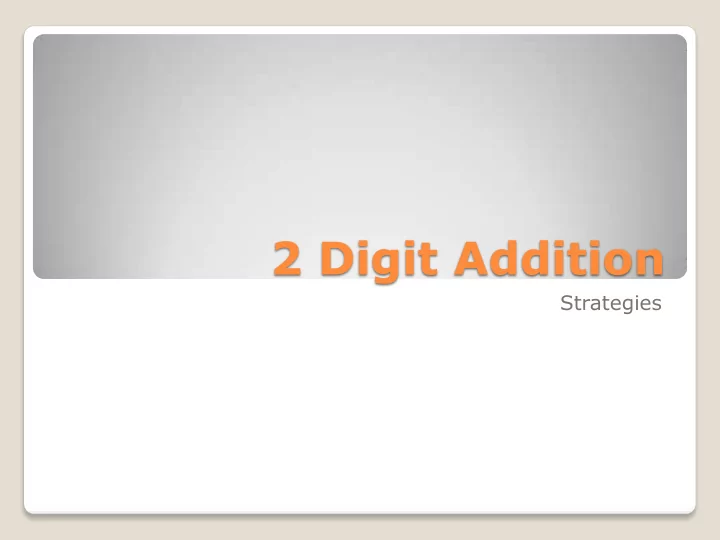

2 Digit Addition Strategies
Example of addition using 100 chart. 25 + 12 =37 S tep 1. Partition the 12 into 10 and 2, then locate 25 on the 100 square (shown blue). Step2. Add on the 10 (obtained when 12 was partitioned) by going down 1 square to 35 (shown red). Step 3. Count on the 2 units (obtained when 12 was partitioned) by going along 2 squares (shown green). Answer 37 Step 4. Remember to write the answer by the original sum. To add larger 2 digit numbers follow the same method, just move down the required number of tens i.e. for 37, move down 3 tens and across 7 units.
"T.U.B." Method "T.U.B." stands for Tens, Units, Both. This is a good strategy for adding two 2 digit numbers and uses partitioning (splitting numbers into tens and units). Here is an example: 25 + 13 =38 Step 1. Partition the numbers ( 20 + 5 ) ( 10 + 3 ). Step 2. Add up the tens (put "T" at side). T 20 + 10 = 30 Step 3. Add up the units (put "U" at side). U 5 + 3 = 8 Step 4. Add "T" and "U" answers together B 30 + 8 = 38 (put "B" for both). Step 5. Remember to put the answer at the end of the original sum
Empty Number Line Method 37 + 21 = Step 1.Draw a horizontal line with a ruler. Step 2.Put a circle at the left hand end like this. Step 3. Partition 21 into 20 and 1 (2 tens and 1 unit). Step 4. Draw to large jumps representing the two 10's and write the numbers underneath as before. Step 5. Draw 1 small unit jump and write the number underneath as before remembering that this is only a count of 1 and not 10. Step 6.Remember to put the answer (58) by the original sum.
Example of addition using Compensation. 28 + 13 = 41 S tep 1. Add 2 to 28 to make it 30. Step2. Subtract 2 from 13 to compensate for the 2 you added to 28. Step 3. Add 30 + 11 = 41 Step 4. Remember to write the answer by the original sum.
2 Digit Subtraction Strategies
The Trick When there is no regrouping of tens and ones, the trick can be used for fast calculation. Simply subtract the number of tens from the greatest number and then the ones.
Friendly Numbers When using friendly numbers, students will add or subtract to make the lesser number in the subtraction sentence friendly by rounding it to the nearest ten. As you add or subtract to the lesser number, you also have to add or subtract that same amount to the greatest number. Once this is completed, students can use the much more simple strategy, “The Trick”.
Open Number Line The first step when using an open number line is to draw a blank number line. We then place the lesser number at the beginning of the number line and the greater number at the end. Students will then add until they reach the greater number. Students will often add a smaller number to reach a friendly number and then make larger jumps in multiples of ten until they reach the end of their number line. After all the jumps have been made, students can add the number of jumps to find the difference between the two numbers.
Hidden Facts Hidden facts are much like using the traditional algorithm. Students will rewrite the subtraction sentence vertically so the tens and ones line-up in both numbers. If the ones in the greater number are less than the ones in the lesser number, the students must find the “hidden fact”. In order to find the hidden fact, you need to borrow a ten from the greater number and add it to the ones place value. This will then allow for basic subtraction without any further regrouping.
Recommend
More recommend